The Mystery of Nontron
by Michael Yoh
I’m always intrigued by knives that are a bit different, or a bit mysterious. Perhaps it’s the lack of a tang mark or any other indication of the manufacturer that catches my attention; or if there is a name, it is one that I haven’t heard of before.
Each month I look forward to the swap session of our local knife club, The Mason Dixon Knife Collector’s Club. I collect RWB (red, white, & blue flag celluloid) knives of the 1920’s, but an odd piece always catches my eye. Maybe it is an abused older pocketknife that could use a bit of cleaning, rehandling, or tightening of the blades. Occasionally, it is the mysterious knife that lures me.
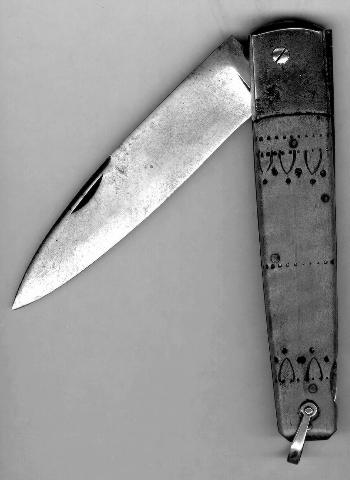
For several years one of our members, “PeeWee” Halterman, had in his knife roll a large, single blade lock back folder with no tang stamp or other markings on it. He had taken it in trade and knew nothing about the knife. It was a large knife, almost 5 1/2″ long closed. The handles appeared to be boxwood, or some variation. There was a motif wood burned into the handle that looked like the letter U with three dots around the top of the arc. There was a brass bail at the end, and I thought the knife had a Finnish flavor to it- a straight blade and handle. It reminded me very much of the puukko design. I assumed that it was possibly handmade, that being the reason there was no tang mark. I was intrigued with the knife, but PeeWee’s $125.00 price tag deterred me, as I had no idea of the value. Obviously, the price and anonymity of the knife kept everyone else away, too.
This past Spring of 1996, I showed the knife to a life-long friend, Will Pananes, who had accompanied me to the Annual Knife Show put on by our Club. He, also, thought the knife was most interesting as we talked to PeeWee about it. I mentioned that I had been tempted by this knife for a few years, but had not been able to convince myself to buy it.
On Christmas, 1996, Will handed me a wrapped present to open. He has surprised me with a few Hawbaker muskrats and other unique presents in the past, but I had no idea what this could be. It turned out to be the mystery knife that he had purchased from PeeWee the week after the knife show and kept for me until Christmas. I now owned the mystery knife, but the origin of this knife was beginning to intrigue me even more. I posted an inquiry on the “rec knives” newsgroup to see if anyone could identify the knife, but to no avail. I e-mailed a few of the knife experts and none could positively identify it, though one did say that he thought it may be of French origin.
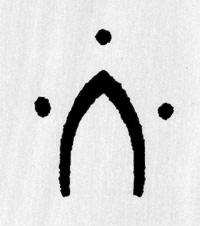
About two months ago, when all the Christmas catalogs started arriving, I was looking through an outdoors clothing catalog, The Territory Ahead, and saw two knives for sale that looked very familiar. Upon close inspection, I saw that the detailing on the handles of these knives was identical to those on my mystery knife, as was the handle material (boxwood) and the bail type. The product information on these Nontron knives stated: “NONTRON is a tiny village in the south of France where, for the past 500 years, artisans have been crafting some of the world’s finest pocketknives. Each Nontron knife is an original work made by one of only six artisan knifemakers. The stainless steel blades are forged. The dense boxwood handles come from local grown trees, which have been allowed five years to air-dry before cutting, shaping, and finishing. Signature woodburned motifs encircle the handles.” The larger knife had a price of $98.00, which, to me, would put it into the premium category.
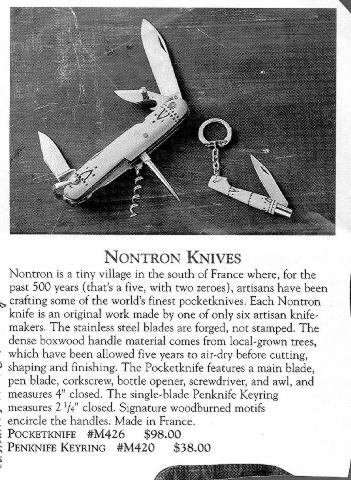
I e-mailed customer service at Territory Ahead, and they were kind enough to give me the name and phone number of the U.S. importer of these knives. Convinced I was on the right track, I called the importer, Euroblade in Evergreen, Colorado, and spoke to Pat Newman, who with her husband owns this company. Pat was most helpful and was enthusiastic about helping me determine if the knife I possessed was an older Nontron knife. Pat mailed me their Nontron catalog; and I, in turn, sent her a picture of my knife. Pat told me she would forward this picture to the factory in Nontron, France, for verification
I assumed that I would have to be patient for a good while until I had a response from Nontron. Much to my surprise, Pat Newman called me about three weeks later and told me that yes, indeed, my knife was a Nontron; and in fact, the very craftsman that made the knife was still working at the “factory” and remembered making the knife. His name is Gerard Chaperon, one of the six artisans, and in about 1963 he made a limited number of this pattern. The journey was now complete- I had progressed from not even knowing the origins of my mystery knife to hearing from the very craftsman who personally made it.
As I imagine most of you reading this article have not heard of Nontron before (after all, I couldn’t find it in Goins or any other knife source), perhaps I should present of bit of history and specifics of the Nontron brand of knives.
NONTRON
Nontron knives have been fashioned in the tiny village of Nontron in the Perigord region of France for the past 500 years. The techniques used have remained nearly the same since the fifteenth Century- individual craftsmen using their own rasps. anvils and finishing tools to create a work of folk artistry. Each knife is an original work by one of only six artisan knifemakers. The blade is forged either from 440 stainless or high carbon steel, then tempered. The boxwood used on every Nontron knife is cut only in the region and allowed to air-dry for five years before being cut and shaped. The factory, if this small building can be called that, is the oldest continuously operating cutlery forge in France.
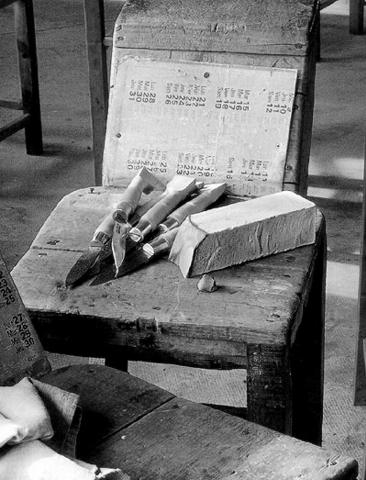
“The fidelity of wood and steel”- is a most fitting motto for Nontron knives. This oldest French knife dates to the 15th Century. The sword of Charles VII was forged in Nontron, as was the cutlery of many other notable figures throughout history. Boxwood on the handle has a symbolical value in that it is eternal; it stays green all year. The Nontron was instrumental as a rite of passage for boys in the region; the acquiring of a Nontron signified manhood.
Each knife is hand decorated with the wood burned logo, which has an ancient but unknown significance. Unlike most knives, the handle of most Nontrons thicken toward the blade to prevent the hand from slipping forward.
In 1928, the individual craftsmen of Nontron joined to form the Nontron Co. However, throughout the years it has remained a small company with just six craftsmen individually making each knife from its beginning through the 40 operations necessary to produce a finished knife. The total output of Nontron knives is about 30,000 knives per year.
In 1992, Nontron merged with Laguiole, another old line of French knives. This knife has been produced commercially since 1829 and is considered by many to be the most elegant of French knives. However it is the intent of the parent company to keep the two identities separate and to keep them unchanged.
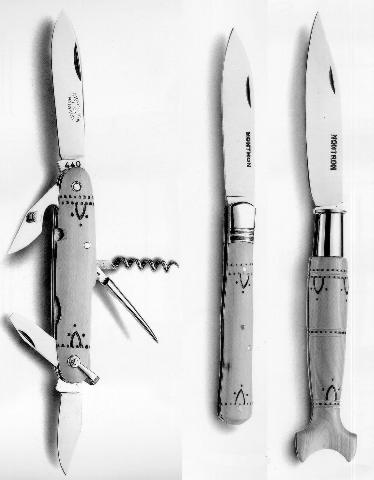
Most people have heard of Opinel, the very fine French country knife. However, how many of you have heard of Nontron? Both of these knives started as cottage industries in France and are famous in their respective regions, as well as the whole of France. Perhaps through marketing strategy, the Opinel has been introduced to the rest of the world, but the Nontron has remained France’s secret. Also, the Opinel is relatively inexpensive compared to the Nontron, and I’m sure that the quantity of Opinels produced each year is many times greater than the number of Nontrons produced. Regardless of its lack of international notoriety; the Nontron is a very high quality knife, one that deserves a close look by knife enthusiasts who appreciate fine cutlery. I know that I intend to purchase one from the broad selection available in the Nontron catalog from Euroblade to complement my older Nontron “mystery” knife. I would suggest that you, too, may benefit by contacting the Newmans at Euroblade, and requesting a Nontron catalog.
You may contact the Newmans at: Euroblade 2051 Kerr Gulch Road Evergreen, CO 80439
Phone: (800) 706-0183 or (303) 526-1138
Copyright (C) 1999 Oregon Knife Collectors Association. No part of this article may be reproduced without permission of the OKCA.
